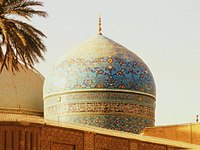fiction.wikisort.org - Writer
Khwaja Ghulam Farid (Urdu: خواجہ غُلام فرید) or Khwaja Fareed (1845–1901) was a 19th-century Sufi poet from Punjab.[2] He was a member of the Chishti Nizami Sufi order. He wrote poetry in several languages, and his literary heritage has been claimed by both the Punjabi and the Saraiki language movements.
Khwaja Ghulam Farid خواجہ غُلام فرید | |
|---|---|
 | |
| Born | 1845[1] Chachran, Bahawalpur, British India (now in Punjab, Pakistan) |
| Died | 24 July 1901 (aged 55)[1] Chachran, Bahawalpur, British India (now in Punjab, Pakistan) |
| Resting place | Mithankot, Punjab |
| Nationality | Indian |
| Notable work | Diwan-e-Farid Manaqab-e-Mehboobia Fawaid Faridia |
Early life
Farid's mother died when he was four years old and he was orphaned around the age of eight when his father, Khwaja Khuda Bakhsh, died. He was then brought up by his elder brother, Khwaja Fakhr-ud-Din, also known as Khwaja Fakhr Jehan Sain, and grew up to become a scholar and writer. He wrote kafi poems in Punjabi, Sindhi, Urdu, Persian, and Braj Bhasha.[citation needed]
Sadeq Mohammad Khan III Nawab of Bahawalpur took Farid to his palace at Ahmedpur East for his religious education by a scholar, when he was 8 years old. His brother Fakhr-ud-Din, who had brought him up after his parents' deaths, also died when Farid was 28 years old. Farid then left for the Cholistan Desert (also known as Rohi) for chilla (retreat) where he lived for 18 years. Most of his work includes mentioning of the beauty of this place.
Farid performed hajj (pilgrimage to Mecca) in 1876.
Works
His most significant works include:
- Diwan-e-Farid (Punjabi verse)
- Manaqabe Mehboobia (in Persian prose)
- Fawaid Faridia (in Persian prose)

In his poetry, he frequently uses the symbolism of a desert. Namely, he discusses how beautiful the desert is and how it attracted him to stay there for 18 years and how he believed that made him feel close to Muhammad. His work however does also include slightly touching the topic of political affairs, opposing the British rule in Bahawalpur state, writing a letter to the Nawab of Bahawalpur and also mentioning it in some of his poetry.
Legacy
| Part of a series on Islam Sufism |
|---|
 |
|
|
- The 20th century saw the development of a branch of literary studies on Farid's life and work called Fareediyat.
- Today, many religious and educational institutions in Pakistan and India are named after Farid (e.g., Khawaja Farid Government College,khawaja farid University of engineering and information technology in Rahimyar Khan, Pakistan) as are streets and town living quarters.
- A literary award named after Farid – the Khwaja Ghulam Farid Award – is awarded yearly by the Pakistan Academy of Letters in literature, its recipients including Ismail Ahmedani (in 2013) and Irshad Taunsvi (in 2007) among others.[3]
- In 2001, on Farid's 100th death anniversary (urs), Pakistan Post issued a memorial stamp to honour him in its "Poets of Pakistan" series[1]
- Sadiq Public School, the public school built by Nawab Sadeq Mohammad Khan V in Bahawalpur, has a house for the day scholars of the prep section named after Farid, called Fareed House.
- Fareed Gate is the name of one of the historic gates surrounding the old city of Bahawalpur named in Farid's honour.
- The Khawaja Fareed University of Engineering and Information Technology (KFUEIT) in Rahim Yar Khan District was named after Farid.
- Shrine of Khawaja Ghulam Farid in Rajanpur, Punjab is among the 10 most visited shrines in Pakistan.[4]
See also
- Fariduddin Ganjshakar
- Punjabi literature
- Qari Muhammad Muslehuddin Siddiqui
- Pathanay Khan
- Christopher Shackle
References
- "(scroll down to read 'Profile of Khwaja Ghulam Farid')". Paknetmag website. 15 July 2009. Archived from the original on 24 August 2019. Retrieved 28 April 2022.
- Suvorova, Anna (22 July 2004). Muslim Saints of South Asia: The Eleventh to Fifteenth Centuries (Islamic calendar). Routledge. ISBN 1134370059 – via Google Books.
- PAL announces National Literary Awards Academy of the Punjab in North America website, Published 10 August 2007, Retrieved 15 April 2020
- Sumayia Asif (2 November 2015). "10 most visited shrines in Pakistan". The Express Tribune (newspaper). Retrieved 28 April 2022.
External links
Другой контент может иметь иную лицензию. Перед использованием материалов сайта WikiSort.org внимательно изучите правила лицензирования конкретных элементов наполнения сайта.
WikiSort.org - проект по пересортировке и дополнению контента Википедии